Biology
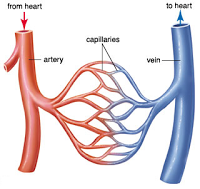 The mammalian circulatory system is a closed double circulation, consisting of a heart, blood vessels and blood.
The mammalian circulatory system is a closed double circulation, consisting of a heart, blood vessels and blood.
The heart produces high pressure --> blood moves through the vessels by mass flow.
The mammalian circulatory system is
closed: blood travels inside vessels
double circulatory:
pulmonary system: heart --> lungs --> heart
systemic system : heart --> around the rest of body --> heart
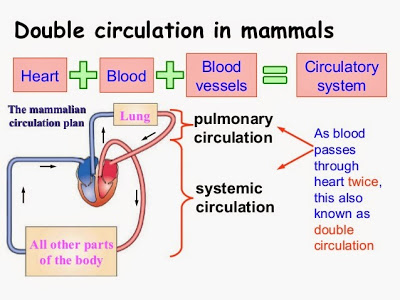
Blood vessels
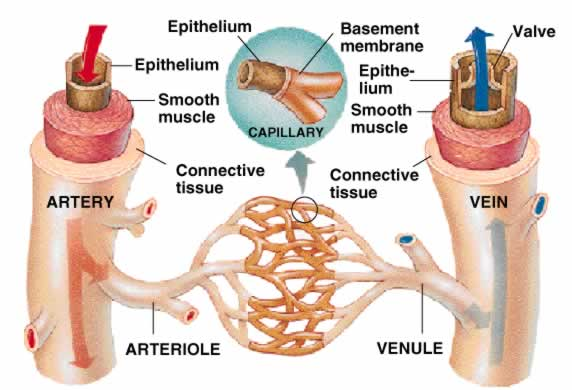
Veins
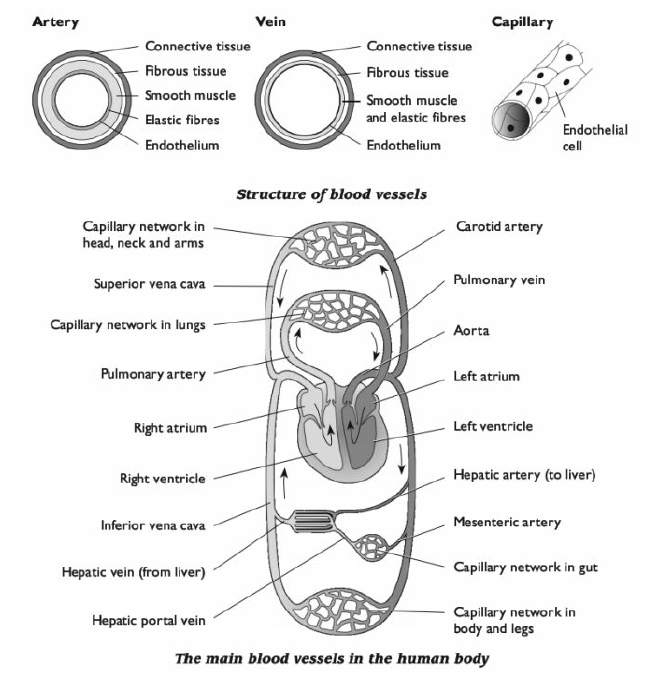
Pressure changes in the circulatory system
The pressure of the blood changes as it moves through the circulatory system.
? In the arteries, blood is at high pressure because it has just been pumped out of the heart. The pressure oscillates (goes up and down) in time with the heart beat. The stretching and recoil of the artery walls helps to smooth the oscillations, so the pressure becomes gradually steadier the further the blood moves along the arteries. The mean pressure also gradually decreases.
? The total cross-sectional area of the capillaries is greater than that of the arteries that supply them, so blood pressure is less inside the capillaries than inside arteries.
? In the veins, blood is at a very low pressure, as it is now a long way from thepumping effect of the heart.
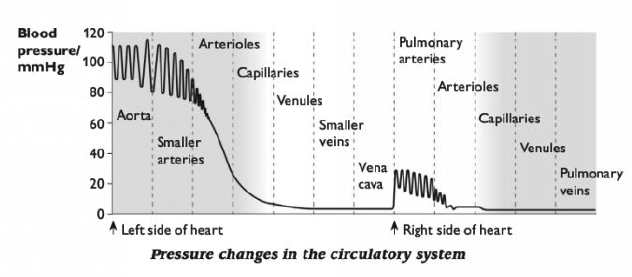
- #83 Question 6
The diagram below shows pressure changes in the left atrium and left ventricle of the heart and the aorta during the cardiac cycle. (a) Calculate how many heart beats there will be in one minute. (2 marks)(b) (i) On the diagram, indicate the point at...
- #49.2 Gas Exchange And Smoking Syllabus 2016
9.1 The gas exchange system 9.2 Smoking The gas exchange system is responsible for the uptake of oxygen into the blood and excreting carbon dioxide. An understanding of this system shows how cells, tissues and organs function...
- #47 Summary Of The Mammalian Transport System
1. Blood is carried away from the heart in arteries, passes through tissues in capillaries, and is returned to the heart in veins. Blood pressure drops gradually as it passes along this system. 2. Arteries have thick, elastic walls, to allow them...
- #46 The Heart
The mammalian heart is a double pump: - The right side pumps deoxygenated blood at low pressure to the lungs. - The oxygenated blood then returns to the left side of the heart in the pulmonary vein.- The left side pumps oxygenated blood...
- #43.1 Transport In Mammals - Syllabus 2015
? The need for, and functioning of, a transport system in mammals ? Structure and functioning of the mammalian heart Learning Outcomes Candidates should be able to: (m) [PA] describe the structures of arteries, veins and capillaries and be able to...
Biology
# 44 The circulatory system - blood vessels
 The mammalian circulatory system is a closed double circulation, consisting of a heart, blood vessels and blood.
The mammalian circulatory system is a closed double circulation, consisting of a heart, blood vessels and blood.The heart produces high pressure --> blood moves through the vessels by mass flow.
The mammalian circulatory system is
closed: blood travels inside vessels
double circulatory:
pulmonary system: heart --> lungs --> heart
systemic system : heart --> around the rest of body --> heart

Blood vessels
Arteries
- Carry blood away from the heart.
- Blood that flows through arteries is pulsing and at a high pressure.
- Have thick, elastic walls which can expand and recoil as the blood pulses through.
- The artery wall contains variable amounts of smooth muscle. This muscle does not help to push the blood through them.
- Arteries branch into smaller vessels called arterioles.
- They contain smooth muscle in their walls, which can contract and make the lumen (space inside) smaller.
- Helps to control the flow of blood to different parts of the body.

Capillaries
- Tiny vessels with just enough space for red blood cells to squeeze through.
- Their walls are only 1 cell thick, and there are often gaps in the walls through which plasma (the liquid component of blood) can leak out.
- Deliver nutrients, hormones and other requirements to body cells, and take away their waste products.
- Small size and thin walls minimise diffusion distance, enabling exchange to take place rapidly between the blood and the body cells.
- Small blood vessels that connect the capillary beds to the veins.
Veins
- Carry low-pressure blood back to the heart.
- Their walls do not need to be as tough or as elastic as those of arteries as the blood is not at high pressure and is not pulsing.
- The lumen is larger than in arteries, reducing friction which would otherwise slow down blood movement.
- Contain valves, to ensure that the blood does not flow back the wrong way.
- Blood is kept moving through many veins, for example those in the legs, by the squeezing effect produced by contraction of the body muscles close to them, which are used when walking.

The pressure of the blood changes as it moves through the circulatory system.
? In the arteries, blood is at high pressure because it has just been pumped out of the heart. The pressure oscillates (goes up and down) in time with the heart beat. The stretching and recoil of the artery walls helps to smooth the oscillations, so the pressure becomes gradually steadier the further the blood moves along the arteries. The mean pressure also gradually decreases.
? The total cross-sectional area of the capillaries is greater than that of the arteries that supply them, so blood pressure is less inside the capillaries than inside arteries.
? In the veins, blood is at a very low pressure, as it is now a long way from thepumping effect of the heart.

Syllabus 2015 (v) describe the mammalian circulatory system as a closed double circulation; (m) [PA] describe the structures of arteries, veins and capillaries and be able to recognise these vessels using the light microscope; (n) explain the relationship between the structure and function of arteries, veins and capillaries; |
Syllabus 2016 As animals become larger, more complex and more active, transport systems become essential to supply nutrients to, and remove waste from, individual cells. Mammals are far more active than plants and require much greater supplies of oxygen. This is transported by haemoglobin inside red blood cells. Learning outcomes Candidates should be able to: 8.1 The circulatory system The mammalian circulatory system consists of a pump, many blood vessels and blood, which is a suspension of red blood cells and white blood cells in plasma. a) state that the mammalian circulatory system is a closed double circulation consisting of a heart, blood vessels and blood b) observe and make plan diagrams of the structure of arteries, veins and capillaries using prepared slides and be able to recognise these vessels using the light microscope c) explain the relationship between the structure and function of arteries, veins and capillaries |
- #83 Question 6
The diagram below shows pressure changes in the left atrium and left ventricle of the heart and the aorta during the cardiac cycle. (a) Calculate how many heart beats there will be in one minute. (2 marks)(b) (i) On the diagram, indicate the point at...
- #49.2 Gas Exchange And Smoking Syllabus 2016
9.1 The gas exchange system 9.2 Smoking The gas exchange system is responsible for the uptake of oxygen into the blood and excreting carbon dioxide. An understanding of this system shows how cells, tissues and organs function...
- #47 Summary Of The Mammalian Transport System
1. Blood is carried away from the heart in arteries, passes through tissues in capillaries, and is returned to the heart in veins. Blood pressure drops gradually as it passes along this system. 2. Arteries have thick, elastic walls, to allow them...
- #46 The Heart
The mammalian heart is a double pump: - The right side pumps deoxygenated blood at low pressure to the lungs. - The oxygenated blood then returns to the left side of the heart in the pulmonary vein.- The left side pumps oxygenated blood...
- #43.1 Transport In Mammals - Syllabus 2015
? The need for, and functioning of, a transport system in mammals ? Structure and functioning of the mammalian heart Learning Outcomes Candidates should be able to: (m) [PA] describe the structures of arteries, veins and capillaries and be able to...
